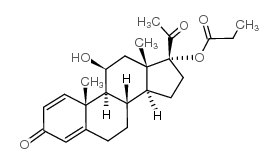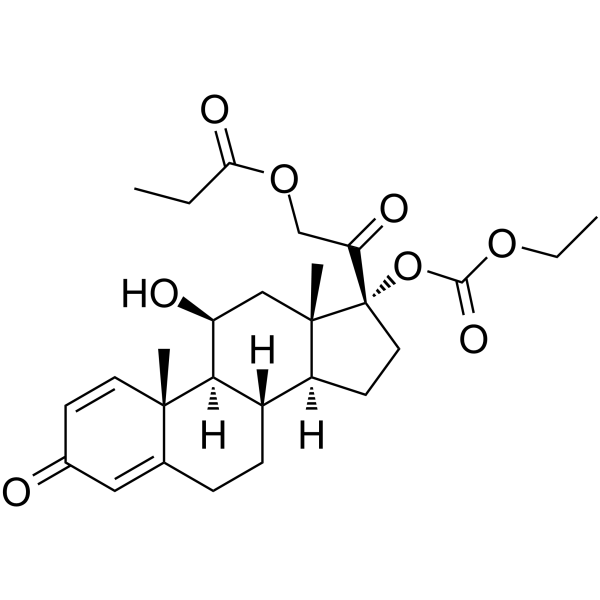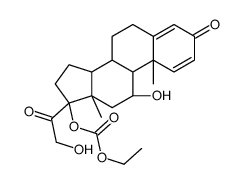50-24-8
| 中文名 | 泼尼松龙 |
|---|---|
| 英文名 | prednisolone |
| 中文别名 |
11Beta,17Alpha,21-三羟基孕甾-1,4-二烯-3,20-二酮
11β,17α,21-三羟基孕甾-1,4-二烯-3,20-二酮 孕甾-1,4-二烯-11β,17α,21-三醇-3,20-二酮 去氢氢化可的松 |
| 英文别名 |
Pregna-1,4-diene-3,20-dione, 11β,17,21-trihydroxy-
D1-Cortisol 11b,17a,21-Trihydroxypregna-1,4-diene-3,20-dione δ1-Dehydrocortisol D1-Dehydrohydrocortisone MFCD00003649 (8S,9S,10R,11S,13S,14S,17R)-11,17-dihydroxy-17-(hydroxyacetyl)-10,13-dimethyl-6,7,8,9,10,11,12,13,14,15,16,17-dodecahydro-3H-cyclopenta[a]phenanthren-3-one 1,4-Pregnadiene-3,20-dione-11b,17a,21-triol Deltasolone δ-Stab deltaf 1,4-Pregnadiene-11b,17a,21-triol-3,20-dione D1-Hydrocortisone δ-Cortef ulacort Pregna-1,4-diene-3,20-dione, 11,17,21-trihydroxy-, (11β)- eazolind Precortalon prednis D1-Dehydrocortisol solone Flamasone Klismacort (11β)-11,17,21-Trihydroxypregna-1,4-diene-3,20-dione Supercortisol 3,20-Dioxo-11b,17a,21-trihydroxy-1,4-pregnadiene d-Cortef Deltisolone d-Stab NISOLONE STEROLONE d-Ef-Cortelan prednisolone δ1-Dehydrohydrocortisone steran dicortol EINECS 200-021-7 δ1-Hydrocortisone hydeltra predonin (11b)-11,17,21-Trihydroxypregna-1,4-diene-3,20-dione δ1-Cortisol 11b,17,21-Trihydroxypregna-1,4-diene-3,20-dione |
| 描述 | Prednisolone是糖皮质素。 |
|---|---|
| 相关类别 | |
| 参考文献 |
| 密度 | 1.3±0.1 g/cm3 |
|---|---|
| 沸点 | 570.6±50.0 °C at 760 mmHg |
| 熔点 | 240 °C (dec.)(lit.) |
| 分子式 | C21H28O5 |
| 分子量 | 360.444 |
| 闪点 | 313.0±26.6 °C |
| 精确质量 | 360.193665 |
| PSA | 94.83000 |
| LogP | 1.50 |
| 外观性状 | 结晶固体 |
| 蒸汽压 | 0.0±3.6 mmHg at 25°C |
| 折射率 | 1.612 |
| 储存条件 | 本品密封避光干燥保存。 |
| 分子结构 | 1、 摩尔折射率:95.48 2、 摩尔体积(cm3/mol):274.7 3、 等张比容(90.2K):766.8 4、 表面张力(dyne/cm):60.7 5、 极化率(10-24cm3):37.85 |
| 计算化学 | 1、 疏水参数计算参考值(XlogP):1.6 2、 氢键供体数量:3 3、 氢键受体数量:5 4、 可旋转化学键数量:2 5、 互变异构体数量:9 6、 拓扑分子极性表面积(TPSA):94.8 7、 重原子数量:26 8、 表面电荷:0 9、 复杂度:724 10、同位素原子数量:0 11、确定原子立构中心数量:7 12、不确定原子立构中心数量:0 13、确定化学键立构中心数量:0 14、不确定化学键立构中心数量:0 15、共价键单元数量:1 |
| 更多 | 1. 性状:白色吸湿性粉末,无臭,味苦 2. 密度(g/mL,25/4℃):未确定 3. 相对蒸汽密度(g/mL,空气=1):未确定 4. 熔点(ºC):240°C (dec.)(lit.) 5. 沸点(ºC,常压):未确定 6. 沸点(ºC, 5.2 kPa):未确定 7. 折射率:100 ° (C=1, Dioxane) 8. 闪点(ºC):未确定 9. 比旋光度(º):未确定 10. 自燃点或引燃温度(ºC):未确定 11. 蒸气压(kPa,25 ºC):未确定 12. 饱和蒸气压(kPa,60 ºC):未确定 13. 燃烧热(KJ/mol):未确定 14. 临界温度(ºC):未确定 15. 临界压力(KPa):未确定 16. 油水(辛醇/水)分配系数的对数值:未确定 17. 爆炸上限(%,V/V):未确定 18. 爆炸下限(%,V/V):未确定 19. 溶解性:溶于乙醇、氯仿、丙醇、甲醇、二氧六环,微溶于水 |
|
Section 1. Chemical Product and Company Identification Prednisolone Common Name/ Trade Name Prednisolone Section 3. Hazards Identification Potential Acute Health Effects Slightly hazardous in case of skin contact (irritant, permeator), of eye contact (irritant), of ingestion, of inhalation.
Potential Chronic HealthSlightly hazardous in case of skin contact (sensitizer). EffectsCARCINOGENIC EFFECTS: Not available. MUTAGENIC EFFECTS: Mutagenic for mammalian somatic cells. Mutagenic for bacteria and/or yeast. TERATOGENIC EFFECTS: Not available. DEVELOPMENTAL TOXICITY: Classified Reproductive system/toxin/female, Reproductive system/toxin/male [POSSIBLE]. Section 4. First Aid Measures Eye ContactCheck for and remove any contact lenses. In case of contact, immediately flush eyes with plenty of water for at least 15 minutes. Cold water may be used. WARM water MUST be used. Get medical attention if irritation occurs. Skin ContactWash with soap and water. Cover the irritated skin with an emollient. Get medical attention if irritation develops. Serious Skin ContactNot available. InhalationIf inhaled, remove to fresh air. If not breathing, give artificial respiration. If breathing is difficult, give oxygen. Get medical attention. Serious InhalationNot available. Ingestion Do NOT induce vomiting unless directed to do so by medical personnel. Never give anything by mouth to an unconscious person. If large quantities of this material are swallowed, call a physician immediately. Loosen tight clothing such as a collar, tie, belt or waistband. Serious IngestionNot available. Section 5. Fire and Explosion Data Flammability of the Product May be combustible at high temperature. Auto-Ignition Temperature Not available. Flash PointsNot available. Flammable LimitsNot available. Products of CombustionThese products are carbon oxides (CO, CO2). Fire Hazards in Presence of Slightly flammable to flammable in presence of heat. Various SubstancesNon-flammable in presence of shocks. Explosion Hazards in Presence Risks of explosion of the product in presence of mechanical impact: Not available. of Various SubstancesRisks of explosion of the product in presence of static discharge: Not available. Fire Fighting MediaSMALL FIRE: Use DRY chemical powder. and InstructionsLARGE FIRE: Use water spray, fog or foam. Do not use water jet. Special Remarks onNot available. Fire Hazards Special Remarks on Explosion Not available. Hazards Prednisolone Section 6. Accidental Release Measures Small SpillUse appropriate tools to put the spilled solid in a convenient waste disposal container. Finish cleaning by spreading water on the contaminated surface and dispose of according to local and regional authority requirements. Large SpillUse a shovel to put the material into a convenient waste disposal container. Finish cleaning by spreading water on the contaminated surface and allow to evacuate through the sanitary system. Section 7. Handling and Storage PrecautionsKeep away from heat. Keep away from sources of ignition. Ground all equipment containing material. Do not ingest. Do not breathe dust. Wear suitable protective clothing. If ingested, seek medical advice immediately and show the container or the label. StorageKeep container tightly closed. Keep container in a cool, well-ventilated area. Section 8. Exposure Controls/Personal Protection Engineering ControlsUse process enclosures, local exhaust ventilation, or other engineering controls to keep airborne levels below recommended exposure limits. If user operations generate dust, fume or mist, use ventilation to keep exposure to airborne contaminants below the exposure limit. Personal ProtectionSafety glasses. Lab coat. Dust respirator. Be sure to use an approved/certified respirator or equivalent. Gloves. Personal Protection in Case of Splash goggles. Full suit. Dust respirator. Boots. Gloves. A self contained breathing apparatus should be used a Large Spillto avoid inhalation of the product. Suggested protective clothing might not be sufficient; consult a specialist BEFORE handling this product. Exposure LimitsNot available. Section 9. Physical and Chemical Properties Physical state and appearance Solid. (Solid crystalline powder.)OdorOdorless. Not available. Taste Molecular Weight360.45 g/mole White. Off-white. Color pH (1% soln/water)Not available. Boiling PointNot available. Melting Point235°C (455°F) Critical TemperatureNot available. Specific GravityNot available. Not applicable. Vapor Pressure Vapor DensityNot available. Not available. Volatility Odor ThresholdNot available. Water/Oil Dist. Coeff.Not available. Ionicity (in Water)Not available. Dispersion PropertiesSee solubility in water, methanol, acetone. SolubilitySoluble in acetone. Partially soluble in methanol. Very slightly soluble in cold water. Prednisolone Section 10. Stability and Reactivity Data The product is stable. Stability Instability TemperatureNot available. Excess heat, moisture Conditions of Instability Not available. Incompatibility with various substances CorrosivityNon-corrosive in presence of glass. Special Remarks onAvoid exposure to moisture Reactivity Special Remarks onNot available. Corrosivity PolymerizationWill not occur. Section 11. Toxicological Information Routes of EntryAbsorbed through skin. Inhalation. Ingestion. Toxicity to AnimalsAcute oral toxicity (LD50): 1680 mg/kg [Mouse]. Chronic Effects on HumansMUTAGENIC EFFECTS: Mutagenic for mammalian somatic cells. Mutagenic for bacteria and/or yeast. DEVELOPMENTAL TOXICITY: Classified Reproductive system/toxin/female, Reproductive system/toxin/male, Development toxin [POSSIBLE]. Other Toxic Effects onSlightly hazardous in case of skin contact (irritant, permeator), of ingestion, of inhalation. Humans Special Remarks on Not available. Toxicity to Animals Special Remarks onMay cause adverse reproductive effects (maternal effects on fertility -post-implantation, and fetotoxicity), and birth Chronic Effects on Humansdefects. May affect genetic material (mutagenic). Excreted in maternal milk in human. Special Remarks on otherAcute Potential Health Effects: Toxic Effects on HumansSkin: May cause skin irritation. It may be absorbed through the skin. Eyes: Dust may cause eye irritation. Inhalation: Dust may cause respiratory tract irritation. Ingestion: May cause gastrointestinal tract irritation. May also affect behavior (toxic psychosis), metabolism (anorexia), and urinary system. This material is readily absorbed from the gastrointestinal tract. Ingestion of a massive single dose is unlikely to cause adverse effects. Chronic Potential Health Effects: Prolonged or repeated exposure by inhalation, ingestion, or skin contact may cause allergic reaction (possible hypersensitization). Other symptoms of chronic overdose effects may include, acne or other skin problems, weight loss or weight gain, hip or shoulder pain, fullness in face, fluid retention associated with sodium retention, potassium loss,swelling of feet or lower legs, excess or abnormal thirst, menstrual irregularities, nausea, vomiting, irregular heartbeat, muscle cramps, weakness, osteoporosis, increased susceptibility to infection, psychosis, and eye problems. May also affect urinary system (polyuria), liver, adrenal gland. Prednisolone Section 12. Ecological Information EcotoxicityNot available. BOD5 and CODNot available. Products of BiodegradationPossibly hazardous short term degradation products are not likely. However, long term degradation products may arise. The products of degradation are less toxic than the product itself. Toxicity of the Products of Biodegradation Special Remarks on theNot available. Products of Biodegradation Section 13. Disposal Considerations Waste DisposalWaste must be disposed of in accordance with federal, state and local environmental control regulations. Section 14. Transport Information DOT ClassificationNot a DOT controlled material (United States). Not applicable. Identification Not applicable. Special Provisions for Transport DOT (Pictograms) Section 15. Other Regulatory Information and Pictograms New Jersey: Prednisolone Federal and State TSCA 8(b) inventory: Prednisolone Regulations CaliforniaCalifornia prop. 65: This product contains the following ingredients for which the State of California has found Proposition 65to cause cancer which would require a warning under the statute: No products were found. Warnings California prop. 65: This product contains the following ingredients for which the State of California has found to cause birth defects which would require a warning under the statute: No products were found. Other RegulationsEINECS: This product is on the European Inventory of Existing Commercial Chemical Substances (EINECS No. 200-021-7). Canada: Listed on Canadian Domestic Substance List (DSL). China: Listed on National Inventory. Japan: Not listed on National Inventory (ENCS). Korea: Listed on National Inventory (KECI). Philippines: Listed on National Inventory (PICCS). Australia: Listed on AICS. CLASS D-2A: Material causing other toxic effects (VERY TOXIC). Other ClassificationsWHMIS (Canada) Class D-2B: Material causing other toxic effects (TOXIC). DSCL (EEC)R62- Possible risk of impaired fertility.S36- Wear suitable protective clothing. R63- Possible risk of harm to the unborn child. Prednisolone Health Hazard HMIS (U.S.A.)1 National Fire Protection 1 Flammability 1 Association (U.S.A.) Fire Hazard 1 0 Reactivity Health Reactivity 0 Specific hazard Personal Protection E WHMIS (Canada) (Pictograms) DSCL (Europe) (Pictograms) TDG (Canada) (Pictograms) ADR (Europe) (Pictograms) Protective Equipment Gloves. Lab coat. Dust respirator. Be sure to use an approved/certified respirator or equivalent. Safety glasses. SECTION 16 - ADDITIONAL INFORMATION N/A |
CHEMICAL IDENTIFICATION
HEALTH HAZARD DATAACUTE TOXICITY DATA
MUTATION DATA
|
| 符号 |

GHS07 |
|---|---|
| 信号词 | Warning |
| 危害声明 | H302 |
| 警示性声明 | P201-P280-P308 + P313 |
| 个人防护装备 | dust mask type N95 (US);Eyeshields;Gloves |
| 危害码 (欧洲) | Xn:Harmful |
| 风险声明 (欧洲) | R22 |
| 安全声明 (欧洲) | S22 |
| 危险品运输编码 | NONH for all modes of transport |
| WGK德国 | 3 |
| RTECS号 | TU4152000 |
| 海关编码 | 2937229000 |
| 上游产品 9 | |
|---|---|
| 下游产品 10 | |
| 海关编码 | 2937229000 |
|---|


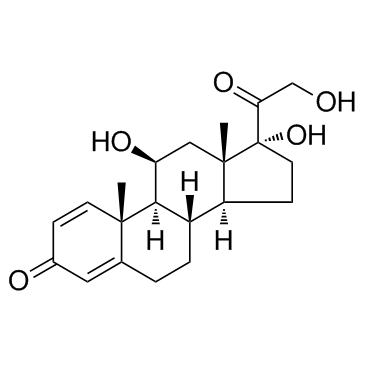


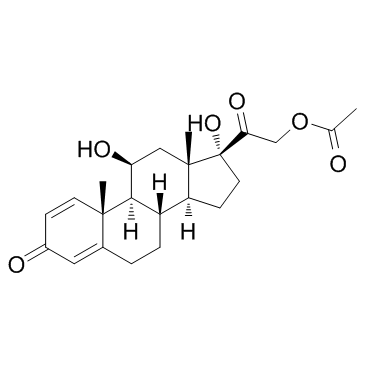

![2-((8S,9S,10R,11S,13S,14S,17R)-11,17-dihydroxy-10,13-dimethyl-3-oxo-2,3,6,7,8,9,10,11,12,13,14,15,16,17-tetradecahydro-1H-cyclopenta[a]phenanthren-17-yl)-2-oxoethyl 3-(2-aminophenyl)propanoate结构式](https://image.chemsrc.com/caspic/439/1154703-42-0.png)
![2-((8S,9S,10R,11S,13S,14S,17R)-11,17-dihydroxy-10,13-dimethyl-3-oxo-6,7,8,9,10,11,12,13,14,15,16,17-dodecahydro-3H-cyclopenta[a]phenanthren-17-yl)-2-oxoethyl 2-(2-nitrophenyl)acetate结构式](https://image.chemsrc.com/caspic/314/1426535-35-4.png)
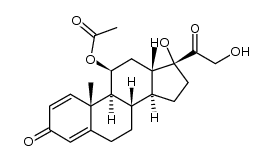

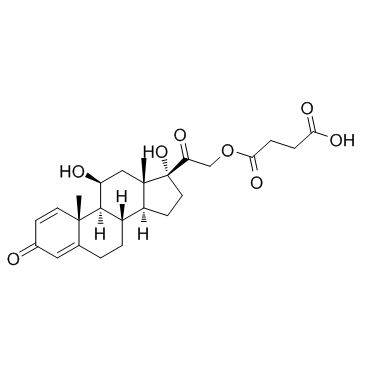
![methyl 11-hydroxy-17-(2-hydroxyacetyl)-10,13-dimethyl-3-oxo-6,7,8,9,11,12,14,15,16,17-decahydrocyclopenta[a]phenanthrene-16-carboxylate结构式](https://image.chemsrc.com/caspic/474/111802-43-8.png)
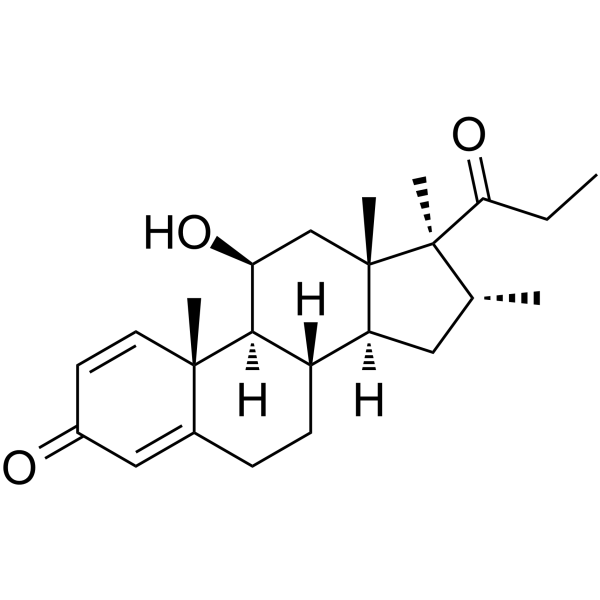
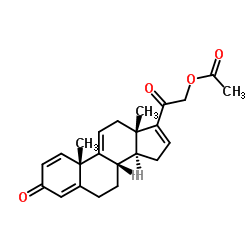
![2-((8S,9S,10R,11S,13S,14S)-11-羟基-10,13-二甲基-3-氧代-6,7,8,9,10,11,12,13,14,15-十氢-3H-环戊并[a]菲-17-基)-2-氧代乙基乙酸酯结构式](https://image.chemsrc.com/caspic/143/3044-42-6.png)
